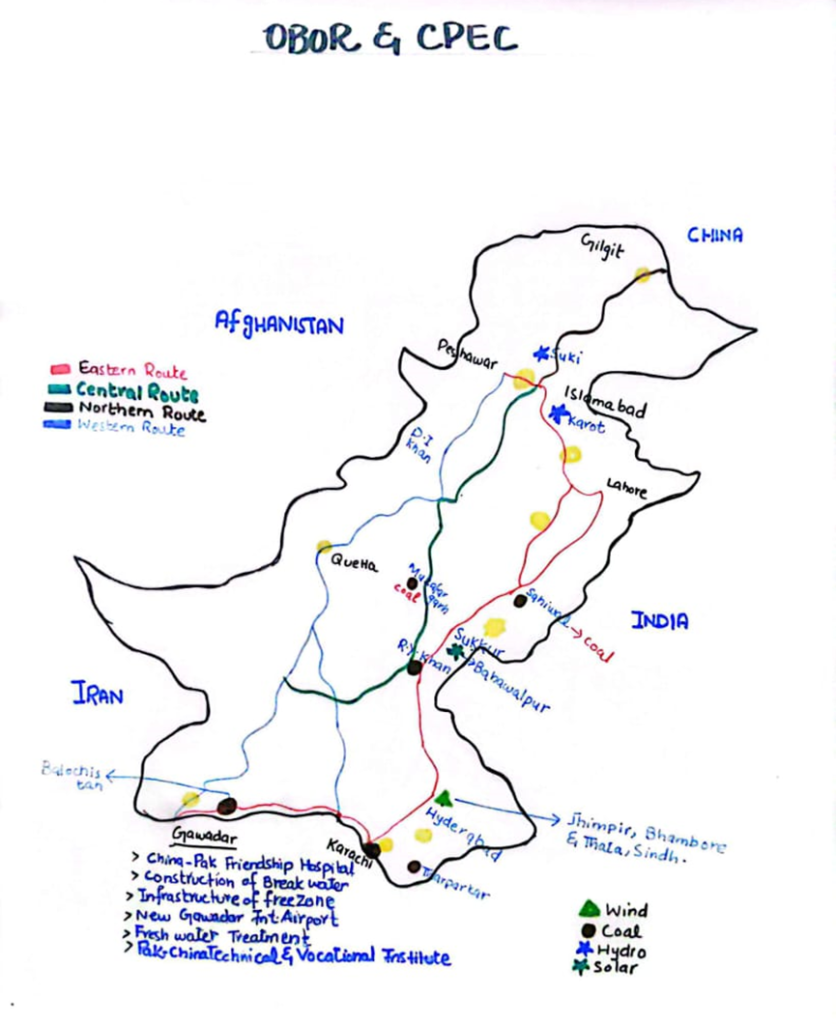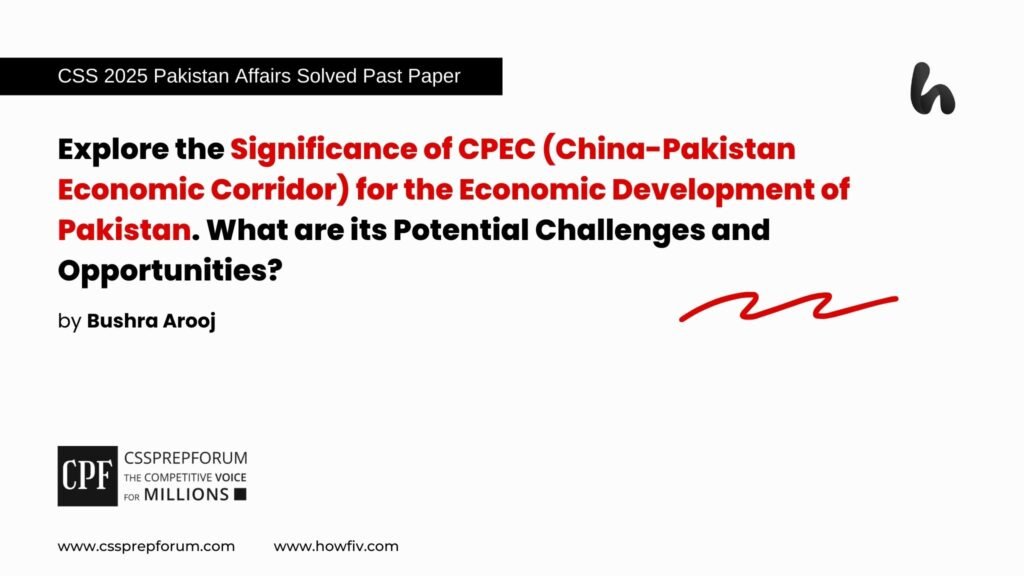CSS 2025 Solved Pakistan Affairs Past Papers | CPEC and its Economic Potential for Pakistan
The following question of CSS Pakistan Affairs 2025 is solved by Miss Bushra Arooj, the best Current Affairs Coach, on the guided pattern of Sir Syed Kazim Ali, which he taught to his students, scoring the highest marks in compulsory subjects for years. This solved past paper question is uploaded to help aspirants understand how to crack a topic or question, how to write relevantly, what coherence is, and how to include and connect ideas, opinions, and suggestions to score the maximum.

Question Breakdown
In this Question, the examiner has asked you to explain the significance, opportunities, and challenges of the Pakistan Economic Corridor for Pakistan’s economic development. Since CPEC’s significance and opportunities overlap, we will start our question with an overview of CPEC, then give equal weightage to opportunities and challenges for the economy of Pakistan with evidence under each argument. Then, end your question by giving suitable suggestions in a paragraph. Do not forget to add a diagram.
Outline
1-Introduction
2-Overview of CPEC and its Significance
- ✓Significance of CPEC
- ✓Key Objectives of CPEC
- ✓Major Projects under CPEC: Infrastructure, Energy, Gwadar Port, Special Economic Zone
- ✓Phases of Development
3-Opportunities Created by CPEC for Pakistan’s Economic Development
- ✓Attract foreign and local investors by assuring sustainable energy security and technological improvement.
- Evidence: The State Bank of Pakistan, in their report 2024, the Pakistani government has implemented several policies to attract foreign investors in the IT sector. Such initiatives have contributed to a 24% increase in IT exports during the fiscal year of 2023-2024, reaching $3.2 billion, up from $2.59 billion the previous year.
- ✓Strengthening bilateral relations with China and other regional partners by serving as a trade corridor through Infrastructural development
- Evidence: According to the research paper published by Pakistan Social Sciences Research (PSSR), named “Geo-political Dimensions and CPEC: Implications for South Asia,” CPEC’s infrastructure projects have the potential to transform regional trade dynamics, and there is also recognition of the economic benefits that enhanced connectivity to the region.
- ✓Uplift socioeconomic conditions by generating revenue and employment opportunities by boosting industrial and manufacturing growth
- Evidence: The report by the International Labour Organization (ILO) Pakistan 2023, CPEC has reduced unemployment in Baluchistan and Khyber Pakhtunkhwa by providing jobs in the industrial sector.
- Social exchange and cultural exchange would pave the way for Pakistani students to get advanced education in China
- Evidence: According to the Pakistan Higher Education (HEC), to enhance educational cooperation between China and Pakistan, the Government of China has launched the “Chinese Government Scholarship Program 2025-2026” to offer Pakistani students to conduct their research in the top universities of China.
4- Challenges in the way of CPEC’s Role in the Economic Development of Pakistan
- ✓Rising External Debt and Sustainability of Loan Repayments
- Evidence: IMF Country Report No. 23/260 categorizes that Pakistan’s external debt servicing rose to $27 billion in 2023, straining the country’s ability to meet repayment obligations.
- ✓Lack of Industrial and Human Resource Development
- Evidence: According to the research report by “The Institute of Strategic Studies Islamabad,” named “COVID-19: Impact on BRI and CPEC”, the projects of CPEC in CORONA went through considerable delay as the major labor force belonging to China faced travelling restrictions and Pakistan’s labor force were not capable of having technical workflow.
- ✓Security concerns among state actors and non-state actors
- Evidence: On 13 August 2023, unknown militants attacked a group of Chinese engineers in Pakistan’s Southern Baluchistan province.
- ✓Lack of transparency Policies in Project Execution caused by political disparities
- Evidence: According to the research report of Observer Research Foundation, “Pakistan: Government Report Uncover Corruption in CPEC Projects,” an internal report of the Pakistani government committee in August 2019 uncovered substantial corruption and opacity in CPEC-related projects.
5- Suggestions to Overcome The Challenges to Utilize CPEC for the Economic Development of Pakisan
- ✓Necessity for Unified and consistent policy formulation to transcend Governance
- ✓Fostering a mutually beneficial partnership between China and Pakistan to reduce socio-economic disparities
- ✓Strengthening the security apparatus for the success of CPEC
- ✓Ensure Environmental and Social Sustainability
6- Conclusion

Answer to the question
Introduction
May 28, 2015, is destined to be a date Pakistan welcomed CPEC as its fate-changer. When the Pakistani then-Prime Minister and Chinese President Xi Jinping signed 51 agreements and memorandums worth $46 Billion, it aimed at enhancing infrastructure, energy, trade, and industrial growth. From Gwadar Port in Baluchistan to Kashgar in China’s Xinjiang province, this flagship project not only strengthens bilateral economic ties with regional partners but also stands out Pakistan as a key player in the trade hub alongside creating employment, developing industrialization, and attracts foreign investment. However, with these benefits come some challenges, such as security risks, governance distress, financial sustainability, and environmental impact, which must be addressed to ensure the CPEC project is a driving tool toward sustainable economic growth.
Overview of CPEC and its Significance
Belt and Road Initiative (BRI) is the Chinese government’s infrastructure project launched in 2013 to improve connectivity and cooperation on a global scale. It is spread over 71 countries across Asia, Europe, and Eurasia via six land corridors. The China-Pakistan Corridor has been proclaimed a flagship project of BRI. CPEC is a network of highways, railways, and pipelines to transport South-Western Pakistan to China’s North-Western autonomous region of Xinjiang, ranging over a distance of approximately 3000 km. It is one of the most significant Chinese foreign investments and is expected to be completed by 2030.
CPEC is the largest foreign investment in the history of Pakistan. It boosts the economy of Pakistan. To date, it has attracted $25 billion in investment in Pakistan since 2015. The infrastructural development, such as road and rail networks, has improved connectivity between rural and urban areas. The development of Gwador port as a deep-sea port enhances Pakistan’s position as a regional trade hub. It has added thousands of megawatts to Pakistan’s electricity grid, reducing power shortages. It has created thousands of jobs. Special Economic Zones (SEZs) aim to boost local industries and attract international companies. It has enhanced Pakistan’s regional influence by making a trade link among China, Central Asia, and the Middle East. It is a transformational project for Pakistan.

To improve the living standards of the people of Pakistan and China, an economic corridor boosting bilateral connectivity, bilateral investment, construction, and people-to-people contact for regional connectivity. Its main objectives comprise:
- Integrated transport and IT systems, including road, rails, air, ports, and data communication channels.
- Energy cooperation
- Agricultural development
- Socio-economic development (poverty alleviation, medical treatment, education, water supply, vocational training)
- Tourism cooperation and people-people collaboration
- Cooperation in the livelihood area
- Financial cooperation
- Human Resource Development
The China-Pakistan Economic Corridor (CPEC) is implemented in multiple phases, typically divided into short-term, medium-term, and long-term, focusing on various areas. The first phase, “Early Harvest Projects (2015-2020)”, mainly focuses on infrastructure, energy, and transport projects. The energy projects include 1,320 megawatt (MW) capacity coal-fired power plants in Sahiwal, Port Qasim and Hub (Baluchistan); 660 MW Engro Thar coal power project; 1000 MW Quaid-e-Azam Solar Park in Bahawalpur is completed. It has also upgraded Pakistan’s national and international highways across the Karakoram Mountains for more reliable Pakistan-China connectivity. Most of the projects of Phase 1 are directly linked to Phase 2, Expansion and Consolidation (2021-2025). Phase 2 is much broader in its scope with multibillion-dollar investment. It revitalizes the high-speed rail lines such as Main Line-1 (ML-1) and Karachi Circular Railway (KCR), which connect Karachi, Lahore, and Peshawar. Additional projects in solar and wind energy, including Jhimpir Wind Power projects. It also galvanized the industrial sector. Pakistan has established SEZs to follow the fruitful experiences of China to increase its growth and eradicate poverty. Phase 2 aimed at the re-industrialization of Pakistan. Phase 3, long-term growth and regional connectivity (2026-2030). This phase will accelerate industrial and regional integration with projects like Allama Iqbal Industrial City, Boston SEZ, Rashakai SEZ, and Dhabeji SEZ.
Opportunities Created by CPEC for Pakistan’s Economic Development
Since 2013, china has emerged as Pakistan’s biggest economic partner through the China-Pakistan Economic Corridors (CPEC), often referred to as the “corridor of opportunities” and rightly described as a “game-changer.”
- ✓ Attract foreign and local investors by assuring sustainable energy security and technological improvement.
The investment in hydropower, wind, and solar energy has improved Pakistan’s energy mix, reducing reliance on fossil fuels. As per the Ministry of Energy, 2023, The Karot Hydropower Project (720 MW) and the Thar Coal Project have helped lessen Pakistan’s energy deficit. Pakistan’s sustainable energy security and advanced IT sector have appealed to significant foreign investors, showing the growing assurance of investors globally. For example, in February 2023, the International Finance Corporation (IFC) announced the doubling of investment in Pakistan, which aims to unlock $2 billion. Pakistan According to the Pakistan Telecommunication Authority, 2023, China-Pakistan Fiber Optic Cable has improved internet and digital connectivity. The State Bank of Pakistan, in their report 2024, the Pakistani government has implemented several policies to attract foreign investors in the IT sector. Such initiatives have contributed to a 24% increase in IT exports during the fiscal year of 2023-2024, reaching $3.2 billion, up from $2.59 billion the previous year.
- ✓Strengthening bilateral relations with China and other regional partners by serving as a trade corridor through Infrastructural development
Being the flagship plan of Road and Belt Initiatives (BRI), it has enhanced the linkage between China, Pakistan, and other regional players, including Central Asia, the Middle East, and South Asia. It has heightened geopolitical and economic cooperation through infrastructural developments such as roads, rails, energy pipelines, bridges, waterways, and highways. According to the research paper published by Pakistan Social Sciences Research (PSSR), named “Geo-political Dimensions and CPEC: Implications for South Asia,” CPEC’s infrastructure projects have the potential to transform regional trade dynamics, and there is also recognition of the economic benefits that enhanced connectivity to the region.
- ✓Uplift socioeconomic conditions by generating revenue and employment opportunities by boosting industrial and manufacturing growth
CPEC led to the production of extensive road networks and motorways, linking major ports like Karachi, Port Qasim, and Gwador to different parts of the country. CPEC has helped transform Pakistan’s socio-economic scenario by bolstering manufacturing and industrial progress, creating employment opportunities, and setting the stage for sustained economic. According to the State Bank of Pakistan annual report (2022-2023), Gwadar Port operations generated $350 million in revenue by 2023, expected to cross $5 billion annually by 2030. In another report by the International Labour Organization (ILO) Pakistan 2023, CPEC has reduced unemployment in Baluchistan and Khyber Pakhtunkhwa by providing jobs in the industrial sector.
- ✓Social exchange and cultural exchange would pave the way for Pakistani students to get advanced education in China
CPEC has opened numerous avenues for the shining students of Pakistan to get a chance to facilitate China’s advanced study environment through structured scholarship programs, academic partnerships, and cultural exchanges. The increased interaction has led to a growing interest among Pakistani students in learning the Chinese languages and culture. Cultural immersion enhances academic prospects and prepares our students for careers dealing with CPEC-related projects. According to the Pakistan Higher Education (HEC), to augment educational cooperation between China and Pakistan, the Government of China has launched the “Chinese Government Scholarship Program 2025-2026” to offer Pakistani students to conduct their research in the top universities of China.
Challenges in the way of CPEC’s Role in the Economic Development of Pakistan
- ✓Rising External Debt and Sustainability of Loan Repayments
CPEC has the power to drive economic development in Pakistan, associated external debt and challenges in loan repayment sustainability pose significant concerns. Pakistan’s reliance on Chinese-built power plants has led to high debt and elevated electricity costs, severely impacting households and industries. IMF Country Report No. 23/260 categorizes that Pakistan’s external debt servicing rose to $27 billion in 2023, straining the country’s ability to meet repayment obligations.
- ✓Environmental Concerns Due to Deforestation for Energy Projects
The construction of energy infrastructure often necessitates clearing forested areas, resulting in inhabitant destruction for numerous plants and animal species. This loss can lead to a decline in biodiversity. Deforestation contributes to increased carbon dioxide (CO2) emissions as trees that sequester CO2 are removed. Removing vegetation cover for energy projects can lead to soil erosion, reduced soil fertility, and increased susceptibility. The Centre for Strategic & International Studies, in its article, “Mapping the China-Pakistan Economic Corridor’s Environmental Impacts,” approximately 70% of the planned energy capacity under CPEC is expected to be generated by coal-fired power plants, significantly increasing greenhouse gas emissions.
- ✓Security concerns among state actors and non-state actors
The success of CPEC comes with rising threats by both state and non-state actors. India has conveyed strong displeasure to CPEC, primarily because the corridor passes through the disputed region of Gilgit-Baltistan. Also, the unstable security situation in Afghanistan poses a spillover risk to neighboring countries, particularly Baluchistan, which is pivotal to CPEC. Groups such as the Baluchistan Liberation Army (BLA) have conducted attacks on CPEC objects and personnel. These attacks have targeted CPEC infrastructure to undermine Pakistan’s economic stability and deter foreign investment. For example, on 13 August, unknown militants attacked a group of Chinese engineers in Pakistan’s Southern Baluchistan province.
- ✓Lack of transparency Policies in Project Execution caused by political disparities
The opaque execution of CPEC projects has exacerbated interprovincial tensions, with smaller province expressing their concerns over unequal distribution and potential marginalization. Corruption and opacity in decision-making have further disrupted the continuity of CPEC projects, with each government prioritizing its agenda. These governance challenges have not only slowed the execution of infrastructure and energy initiatives but also diminished investor’s confidence, reducing potential economic gains. According to the research report of Observer Research Foundation, “Pakistan: Government Report Uncover Corruption in CPEC Projects,” an internal report of the Pakistani government committee in August 2019 uncovered substantial corruption and opacity in CPEC-related projects.
Suggestions to Overcome The Challenges to Utilize CPEC for the Economic Development of Pakistan
- ✓Necessity for Unified and consistent policy formulation to transcend Governance
A bipartisan national policy framework for CPEC should be established to prevent disruptions caused by political transitions. Long-term agreements and legal frameworks should safeguard projects from sudden policy reversals. Implementing strict oversight mechanisms, such as independent regulatory bodies and real-time audits, can curb corruption and ensure transparent project execution.
- ✓Fostering a mutually beneficial partnership between China and Pakistan to reduce socio-economic disparities
Pakistan should work closely with China to ensure that investments are not concentrated in a few provinces but are distributed evenly across the country. Special economic zones should be developed in underprivileged areas like Baluchistan, Khyber Pakhtunkhwa (KPK), and countryside zones to promote industrialization and job creation. Encouraging joint ventures between Chinese and Pakistani businesses can help strengthen local industries.
- ✓Strengthening the security apparatus for the success of CPEC
Given the threats from insurgent groups and external actors, Pakistan must strengthen its security infrastructure, including special task forces dedicated to CPEC projects. Cooperation with China on intelligence-sharing and counter-terrorism efforts is crucial for ensuring the safety of workers and infrastructure.
- ✓Ensure Environmental and Social Sustainability
Large-scale infrastructure and energy projects under CPEC have raised concerns about deforestation, air pollution, and resource depletion. To minimize ecological damages, Pakistan should collaborate with China to adopt “Green Technologies,” such as renewable energy sources, sustainable construction methods, and pollution control measures.
Conclusion
The China-Pakistan Economic Corridor (CPEC) stands out as a transformative initiative with the potential to reshape Pakistan’s economic scenery, enhance regional connectivity, and strengthen bilateral ties with China and other regional players. However, its success hinges on addressing critical challenges such as security threats, political instability, and socioeconomic disparities. By ensuring transparent governance, equitable resource distribution, and inclusive development, Pakistan can maximize the benefits of CPEC for all regions and social classes. With a strategic and sustainable approach, CPEC can promote economic prosperity, fostering a resilient Pakistan while strengthening regional cooperation for mutual growth.

CSS Solved Past Papers’ Essays
Looking for the last ten years of CSS and PMS Solved Essays and want to know how Sir Kazim’s students write and score the highest marks in the essays’ papers? Then, click on the CSS Solved Essays to start reading them.
CSS Solved Essays
CSS Solved General Science & Ability Past Papers
Want to read the last ten years’ General Science & Ability Solved Past Papers to learn how to attempt them and to score high? Let’s click on the link below to read them all freely. All past papers have been solved by Pakistan’s top CSS GSA coach having the highest score of their students.
General Science & Ability Solved Past Papers












